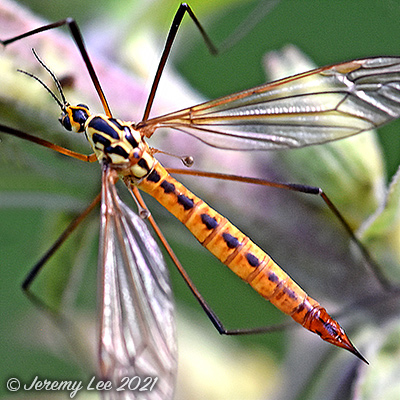
 |
|
Scientific Classifications explained » Amphibians » Ants » Aphids » Bees » Beetles » Birds » Bugs » Butterflies » Caterpillars » Damselflies » Dragonflies » Earwigs » Flies » Frog/Leafhoppers » Fungi » Galls » Grasshoppers » Harvestmen » Hoverflies » Lacewings » Ladybirds » Leaf Mines » Lichens » Mammals » Millipedes » Mosses » Moths » Sawflies » Slugs » Snails » Spiders » Trees & Shrubs » Wasps » Wild Flowers » Woodlice » Postboxes |
UK Nature > Flies > Nephrotoma flaviscens

Scientific Name: Nephrotoma flaviscens Common Name: Crane Fly Nephrotoma flaviscens, a crane fly, is about 18 mm in length. It has a yellow and black thorax and yellow abdomen with a thin and normally broken black stripe down the centre. Nephrotoma appendiculata is a siilar species but has a broader and usually continuous black stripe along the top of the abdomen. N. appendiculata also has a dark horse-shoe mark on the side of the thorax, between the wing base and the haltere, which is missing in N. flavescens. Usually found in hedgerows, verges, gardens and grassy places and is usually seen between April and August. Adults take nectar and pollen from flowers such as Hogweed. Their larvae are virtually indistinguishable from small Tipula leather-jacket grubs. Common and widespread in Britain. |
|

https://www.uknature.co.uk is a website dedicated to showing the immense diversity of UK nature and wildlife. Our vast range of habitats, from lowland arable to snow covered mountains, from storm-ravaged coastlines to peaceful inland freshwater lakes and rivers, from dry, sandy heaths to deciduous and coniferous forests, all these habitats contribute to the abundance of UK nature. We have wild birds in huge numbers either residing or visiting our shores (597 recorded species as at July 2013) and we must also not forget the humble back garden with its grass lawns, flower beds filled with nectar rich flowers, shrubs and trees, all designed to attract huge numbers of insects such as bees, moths, butterflies and hoverflies; and finally the small ponds which provide safe havens for frogs, toads, newts and even slow worms and grass snakes. www.uknature.co.uk is the showcase for my personal passion, photographing uknature in all its glory. I sincerely hope you all enjoy the fruits of my labours. This site and all images contained therein is © Jeremy Lee 2004 - 2025. All Rights Reserved. Site design by Jeremy Lee. Site development & IT Support by Stuart Lee. |